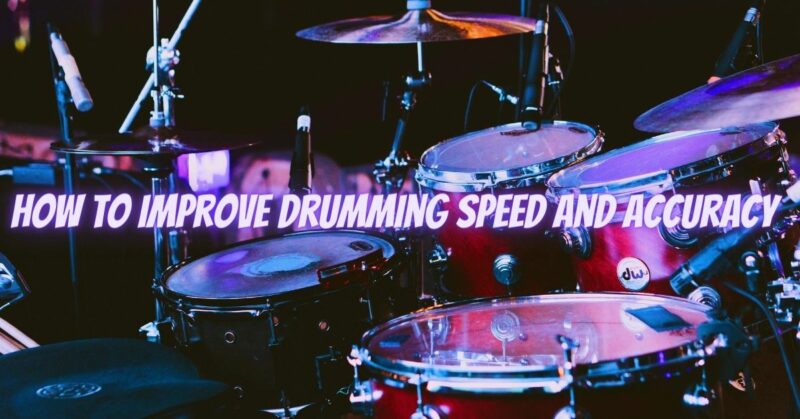Drumming speed and accuracy are essential elements for drummers seeking to expand their technical prowess and deliver impressive performances. Developing the ability to play fast and accurately requires focused practice, proper technique, and a systematic approach. In this article, we will explore effective strategies and exercises to help you improve your drumming speed and accuracy.
- Focus on Technique: a. Maintain a relaxed grip and posture: Ensure your hands and arms are relaxed, allowing for fluid and efficient movement. Tension can hinder speed and accuracy, so practice with a relaxed approach. b. Utilize finger control: Develop finger control by focusing on using your fingers to generate speed and precision. Practice exercises that isolate finger movements, such as finger control exercises or finger rolls, to enhance dexterity and control. c. Utilize the rebound: Maximize the natural rebound of the drumstick by allowing it to bounce off the drumhead after each stroke. This technique facilitates faster and more effortless playing. d. Use efficient motions: Minimize unnecessary movement and utilize efficient motions. Practice sticking patterns that require minimal motion, such as paradiddles, to improve speed and accuracy.
- Metronome Practice: a. Utilize a metronome: Practice with a metronome to develop a strong sense of timing and build your ability to play in sync with a consistent tempo. b. Start at a comfortable tempo: Begin practicing at a tempo where you can play comfortably and accurately. Gradually increase the speed in small increments as you gain control and confidence. c. Focus on subdivision exercises: Work on subdivisions of the beat, such as eighth notes, sixteenth notes, and triplets, to develop precision and coordination. Start at slower tempos and gradually increase the speed over time.
- Progressive Speed Training: a. Implement a progressive speed training routine: Start at a comfortable tempo and gradually increase the speed in small increments. Focus on maintaining control and accuracy at each new speed before progressing further. b. Use timed exercises: Set a specific amount of time, such as one minute, to play a particular exercise or pattern as fast and accurately as possible. This builds endurance and challenges you to maintain accuracy under time constraints. c. Incorporate burst exercises: Practice short bursts of rapid drumming followed by a brief rest period. This helps build speed and stamina, and allows you to focus on maintaining accuracy during intense passages.
- Break Down Complex Patterns: a. Break down complex patterns into smaller segments: When working on intricate patterns, start by practicing each hand or foot separately before combining them. Gradually increase the tempo as you gain fluency and control with each segment. b. Slow down difficult sections: Identify challenging sections in songs or exercises and slow them down to a manageable tempo. Focus on playing the patterns accurately and gradually increase the speed as you become more comfortable.
- Hand and Foot Independence Exercises: a. Practice hand and foot independence exercises, such as limb coordination exercises or polyrhythmic exercises. These exercises help improve coordination and control, allowing you to execute complex patterns with speed and accuracy.
- Record and Analyze: a. Record your practice sessions or performances: Recording yourself allows you to objectively evaluate your playing and identify areas for improvement. Listen for any inconsistencies in timing or technique and make necessary adjustments.
- Gradual Tempo Increases: a. Gradually increase the tempo over time: Avoid rushing the process of building speed and accuracy. Set realistic goals and make incremental tempo increases to ensure steady progress and maintain control and precision.
- Seek Guidance and Feedback: a. Seek guidance from experienced drummers or instructors: Collaborate with drumming professionals who can offer valuable insights, exercises, and guidance tailored to your specific needs. b. Welcome feedback: Be open to feedback from bandmates, instructors, or fellow drummers. They can provide valuable observations and suggestions to help you improve your speed and accuracy.
Conclusion: Improving drumming speed and accuracy requires dedicated practice, attention to technique, and a systematic approach. By focusing on proper technique, utilizing a metronome, incorporating progressive speed training, breaking down complex patterns, practicing hand and foot independence exercises, recording and analyzing your playing, gradually increasing tempo, and seeking guidance and feedback, you can enhance your drumming skills. Remember, progress takes time and patience, so maintain a consistent practice routine and embrace the process. With perseverance and dedication, you will witness notable improvements in your drumming speed, precision, and overall performance.


